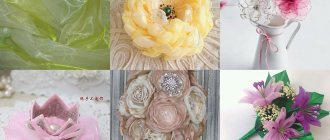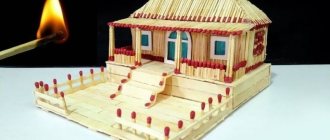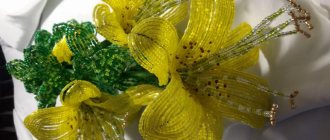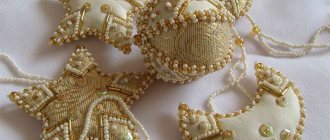Beadwork is experiencing a second round of popularity among the female population. Do-it-yourself beaded flower weaving is very popular among ladies. This type of needlework can be a wonderful hobby that does not require any special skills.
In addition, crafts can become an original gift for a holiday or will highlight the interior and indicate the individuality of the owner of the crafts. The article will discuss all the nuances and analysis of master classes on weaving flowers from beads.
Tools and materials
Experienced needlewomen determine by eye how many beads will be needed for each flower, but beginners need clear instructions.
Standard list of things needed for making flowers:
- beads;
- fishing line;
- wire;
- fabrics and threads;
- sequins and other decorations;
- needles;
- scissors and/or wire cutters.
You can string beads on wire or fishing line. If the flower needs to be stable, craftswomen usually use strong copper wire. A flower bud is rarely complete without a stem. If not wire, then a skewer or toothpick can do the job. The element is masked with thread of a suitable color or wrapped in fabric.
For more information about materials and tools, read the article: “Materials and tools for beading: beads, needles, threads, accessories, how to choose and use.”
Floral tape, designer paper, artistic tape - all this can also be used in floral design. The size of the beads is different. Usually needlewomen take medium-sized beads, small ones. But large beads do not look entirely organic in beadwork of flowers and bouquets. The description of a flower may be complex, but the basis is precisely beads, fishing line or wire, an additional simple material for decoration. Everything else depends on the imagination of the craftswoman.
Blooming apple tree
You can create a similar composition in two options, the first is using the loop technique, the second option is circular weaving. Externally, these woven trees are very different from each other and each one looks beautiful. Apples are created from large beads or cold porcelain. In order to learn in detail how beaded fruit trees such as apple, cherry or citrus fruits are made, you need to watch several lessons on our website.
Fluffy cactus with beaded flowers
A very beautiful cactus and lifelike. It can be a good addition to the interior of your room, place it near your computer for beauty, it will definitely lift your spirits! And yes, it doesn’t need to be watered...at all, even once a year
Let's start with the basics
In order to make a base for a cactus, you need to find a piece of foam plastic or buy a ball or egg shape from a craft store, since they are the most common and you can shape the cactus yourself. Use a regular stationery knife to cut off any excess. Now you can paint the finished base with green paints. Anything you have at home will do.
Now we weave thorns
The spines consist of wire 0.3 mm in diameter and green beads No. 10. Place 10 beads on the wire, close it in a ring, pass the second ring through 5 beads and tighten. You will get an oval ring. Leave one end of the wire about 1 cm, and the other about 4 cm. Make 2 more such rings and twist them together. Here you have the main fragment of a cactus spine. Now weave an even larger bunch of exactly the same ones and carefully stick them one by one into the foam base.
Making flowers
The flowers consist of wire 0.3 mm in diameter and yellow or pink beads No. 10. Each flower consists of loops gathered into a bunch. The size of the loops can be different, it all depends on your desire and planned design. In the example, the flowers are different; a real cactus has even larger flowers, so use your imagination.
On average, a large flower can consist of twenty loops, and a small flower can consist of 10-12 pieces. I showed an example of production above using visual photos. This is a very simple process and I think you can do it with ease. All the elements of a cactus are very simple, but there are many of them and that’s why the work is painstaking. However, the more work you put into your work, the more you value the result. So I wish you all good luck and lots and lots of patience!
Birch - a symbol of Russia
The difference between birch and other species is its white bark with black veins. Make the tree thin; you should not greatly expand the crown towards the bottom. The trunk should be tall and only 2/3 covered with foliage. The veins are made with a thin brush, black. Start at the bottom and work your way up, gradually decreasing the intensity.
A slender and neat tree is just a sight for sore eyes!
Specifics of selecting compositions for the style of celebration
Every bride should know these rules:
the bouquet should complement the dress, and not compete with it. A lush dress, richly decorated with beads, should be complemented by a modest bouquet. Conversely, a formal dress can be complemented with a bouquet of large mother-of-pearl beads; carefully select the shape of the bouquet
Ask the florist to show you all the options, even the most incredible ones; Pay special attention to the handle of the bouquet. Braid it with satin ribbons in the color of the overall holiday color
Make sure the handle is not too big; The aroma of flowers is an important component of the entire bouquet. You can drop a drop of your favorite perfume on artificial flowers.
Also, to create a style, it is important to know the trends of 2022:
- small bouquet;
- coral shades;
- ombre effect;
- garden style;
- ears of corn and grass;
- mono bouquets;
- one color accent.
All this can be realized with the help of beads and beads.
History of beading
An ancient, widespread type of creativity develops simultaneously with the advent of new fashion trends and progress in society. Small glass and plastic beads with a through hole are used for weaving jewelry, headbands, and creating various compositions.
The birthplace of beads is Ancient Egypt. Interest in the material began with the advent of glass more than 3,000 years ago. At first, large opaque beads were used to decorate the clothes of the pharaohs, then they began to simply string them on a thread and use them as beads. The invention of mesh hemming made it possible to produce individual products from round material. Patterns and diagrams were developed, beads were combined with precious stones and metals.
Products made from beads were so good that the Egyptians began to exchange them and turned them into items of trade. Thus, beadwork spread throughout the world. In the 12th century, the capital of beads and related needlework was Venice, which once received settlers from Greece.
In the 18th century, glass factories appeared in France, Germany, America, and Bohemia. Special machines speeded up the production of the material, which affected its price. European fashionistas began to show great interest in beads. They used it to embroider clothes and decorate wallets and handbags. In the 20th century, beadwork reached its peak of popularity. Now unique paintings, panels, all kinds of decor and accessories are made from it.
How to achieve a good flower appearance
Before you begin, carefully read the description of the model manufacturing process, think over the color scheme of the product (it may be the same as the one proposed or differ from it) and select the appropriate material. It is not necessary to choose beads of the specified number - sometimes using a different material leads to very interesting and unexpected results.
It is very convenient to use special colored wire for making flower arrangements, which can be purchased in flower shops or in specialized departments that sell everything necessary for needlework. This wire comes in white, gold, red, green, dark green and other colors. If it is not possible to purchase special colored wire, you can use ordinary copper or steel wire, which is used in various electrical appliances in the form of transformer windings or filling insulated wires.
Beads are a fairly heavy material, and some complex or large products made from it turn out to be quite heavy. Therefore, sometimes to strengthen the stems of flowers they use a special floral wire with a diameter of 0.6-1.2 mm - it is sold in flower shops in the form of bundles of pieces 0.25-0.40 m long. Having a small diameter, such wire is elastic enough to give the flower the desired shape.
It may happen that while working on the product the wire breaks. If this happened at the beginning of the work, it is easier to start executing the element again. If a significant part of it has been completed, it is necessary to release the torn end, unraveling the last few rows, and secure it using one of the methods proposed below.
The first way is to pass each end of the wire back along the product (Fig. 1 a), repeating the weaving principle. This is only possible if the wire passes through the bead hole several times. If the beads are too small or the wire is thick, they resort to the second method: the ends of the wire are carefully passed through the loops between the rows along the edge of the product (Fig. 1b). If, during the description of the models, you come across indications of the need to close the ends of the wire, you can use any of the proposed methods.
Sometimes, to give a product the desired shape, it is necessary to fasten several elements together. To do this, an additional wire of the required length is cut, one end is threaded into the loop between the rows along the edge of the first element, and the other passes through the symmetrical loop of the second element in the same way. Then they cross and are threaded again into the next loops (Fig. 2a) - and so on until the end of the connection.
Popular articles 4 designs from a CD can
If it is necessary that all the petals of a flower or the elements of the cup are located at the same level, then with the help of additional wire all components are connected into a ring. The wire passes along the bottom row of each element - they are, as it were, strung on it one after another - and twisted tightly (Fig. 26). Sometimes you can not resort to additional wire, but use one of the wire ends from any element, if, of course, its length allows it.
If you did not make the flower stems from green wire, you will have to wrap them with threads or paper matched to the color of the leaves. Let's consider the sequence of performing this work. First you need to determine how long the stem will be and cut the ends of the wire at the selected level. Wrapping the stem begins from the calyx of the flower. To do this, a drop of PVA glue is applied to the base of the petals, then several turns of thread or paper are applied to this place - this way the end of the winding is secured.
After this, carefully, turn by turn, wrap the stem, and the places where the leaves are attached should be located between the turns of the winding. When the turns approach the end of the stem, you need to apply a little glue to it and secure the end of the winding. If the stem has a branched structure, then the side branches are wrapped first, and then the main stem, while the junctions of the branches are carefully masked with threads.
Dionysus
Where did this name come from? In ancient Greek mythology, it is believed that this is the god of the fertility of vegetation, viticulture, which means that the difference in appearance is the presence of small clusters. In this work you can get creative with the color scheme; usually bright colors are chosen and woven in the form of large berries of any shape. Beading occurs using a loop technique consisting of three blanks with five loops. As a result, these three branches are connected by twisting and a bud is obtained. Then two identical buds must be twisted together and a beautiful cone is formed. The ancient Greek Dionysus is created from two colors, for example, red - cones and green - petals.
Workplace organization
To make working with beads fun and enjoyable, you need to not only stock up on the necessary materials and tools, but also take care of the convenience of your workspace, especially how to arrange the beads on it. You can take a piece of plain flannel, fold it several times to make it look like a flat pillow, and sprinkle beads of the desired colors on it in small piles.
Some people think that it is more convenient to use a shallow saucer or box with low sides for work. But if you need multi-colored beads, then you will need a separate saucer for each color - otherwise the beads will get mixed up. In this case, plates from a children's toy dish set or jam sockets are suitable. If there is room on the table for only one container, place a piece of rough fabric in it - the beads will not roll around too much.
It is very important that when working with beads, the workplace is well lit, otherwise your eyes will get tired. To give them rest, you need to take a break of 10-15 minutes every hour.
If children take part in working on the bouquet, do not let them sit at this activity for too long. 6-8 year olds can work with beads no longer than 30-45 minutes, 9-11 year olds - 45-60 minutes, and teenagers 12-16 years old - an hour and a half a day.
Recommendations
The good thing about weaving trees is that it is very suitable for beginners. Usually, the production of various crafts is carried out according to special diagrams that you need to be able to read, but here this is not necessary. To master the basics, a couple of video lessons will be enough.
Before starting work, experienced craftsmen advise:
- select fishing line and threads to match the beads;
- lay a felt or velvet napkin on the table so that small beads do not scatter;
- It is better to buy glass beads of the same size and with a reserve;
- It is better to store beads sorted by color and size in special boxes.
When you manage to master simple techniques and develop a good weaving speed, you can safely take on more complex products.
DIY compositions and bouquets made of beads
This master class will help you create a whole composition of flowers from beads yourself. We will place our bouquet of daisies and beautiful lilies in a regular basket and decorate it with a ribbon, and plant a bright, exotic butterfly on top. So, let's get started by preparing all the necessary materials:
- bamboo sticks;
- green and white wire;
- beads: green, white, yellow and beige;
- golden beads;
- green floral ribbon;
- an ordinary plastic pot;
- green wool threads;
- basket;
- glue gun;
- gypsum;
- PVA glue;
- plasticine;
- ribbon;
- Double-sided tape.
It is best to start beading with the lily, since it is the most voluminous and labor-intensive: First, we will need to take 40 cm of wire and fold it. Then you need to put 19 beads on the long tip, and 15 beads on the short one. After this, we screw the longer end to the short one. After this, we again string 19 beads onto the long end and secure it. Thus we have the first row. Each side of the second row will consist of 24 beads, and the third - of 32 pieces. Using the French weaving technique, we will make a petal for our lily.
In total we will need 6 such petals. Then we will need to make the center for the lily. To do this, we need to string 21 beige beads and a golden bead onto a 30-centimeter piece of wire closer to one of the edges. Now we must pass the long end of the wire through the beads and secure it, and then string the beads and beads onto it again and push it through the beads again. Using this weaving pattern, we need to create 5 stamens and connect them together.
Then we will need to connect together all the details of the future flower. The resulting lily will need to be attached to half a bamboo stick and wrapped with floral tape. After we finish weaving the lily, we will need to prepare a pot so that it can be “planted”. First we will cover the bottom of our pot with plasticine. Then, using double-sided tape, decorate the handle of the basket with ribbon. After this, we will need to place the pot in the basket. In order for it to hold tightly and not fall out, we first coat the edges of the basket with glue using a gun, and then insert the pot there. Now we can “plant” a lily in our pot.
At the next stage, our master class will tell you how to make small beautiful daisies. First, we will need to string 14 white beads onto a 25-centimeter piece of wire. Then we will have to pass the wire through 1 bead, and carefully tighten it to secure the resulting loop. In this way we will need to make 7 petals for the chamomile.
Now we can start making the core. To do this, we will need to string 6 yellow beads onto a piece of wire 9 cm long. Then we will have to insert one end of the wire through the 3 outer beads. By carefully pulling the wire and twisting its ends, we get a core like this:
After this we will screw the core to the petals. Having made 3 such daisies, we will screw them to half of a bamboo stick. Then we will need to wrap the resulting stem with green thread. Having created the required number of stems with daisies, we will need to insert them into the basket. Then, using the French weaving technique, we will need to make jagged leaves according to this pattern:
We will have to attach each leaf to a bamboo stick and wrap it with floral tape. After this, we will need to “plant” them in the basket. Then we will have to fill the drainage basket and carefully pour the plaster. After the plaster has dried, we will need to pour PVA glue into the pot and place green woolen threads on it. In the end, all we have to do is attach a beautiful butterfly to the handle of the basket and we can say that our composition is ready. In order to find inspiration and find something new and interesting for yourself, you can also look through photos of finished works, which depict various beaded flowers in pots:
Whatever exotic flower or unusual composition you decide to make from beads, the main thing is that you are not afraid to experiment and boldly bring your fantasies to life. After all, each of your creations will undoubtedly become a real work of art and will delight you and your loved ones for many years.
Popular articles Decorating a bottle with colored salt
Advice from professionals
Let's say you decide to weave a birch tree from beads for beginners. Before you find a simple master class, be sure to take a look at the general recommendations. They will save you from mistakes that beginners often make.
Everything in the instructions is detailed - the algorithm for weaving a specific product. And there are rarely truisms that a beginner may not yet know.
Hairpin "Morning Flower"
Author of the work: Anya Yakubovskaya
The morning sun covers everything around with golden pollen and of course does not miss the beautiful flowers. Today we will create such a flower from beads.
For this we need:
1. First, glue the stone to the felt and begin sewing gold beads around it. We sew with a “back needle” seam through 2 beads.
2. Then we begin to weave mosaics:
3. At the end, when the main part is sheathed, we narrow it, skipping the beads. Because I got 36 beads in the circle, so I weave 2 as usual and skip 3:
4. Cut the felt to the shape of the leaves, but a couple of millimeters less:
5. Now we begin to embroider. First of all, we outline our embroidery, then, while embroidering, we make some stitches looser. We also take gold beads along the edge of the petals. Don't forget about the dew:
6. We complete the embroidery itself:
7. Carefully trim, cut off a piece of leather of the same shape and sew the edges. I worked bead stitches around the edge.
8. All that remains is to glue it onto the workpiece and now we can see the flower, which, you can be sure, will sparkle on your hair.
Interesting facts about wicker trees
A tree made of beads, made with your own hands, not only absorbs the positive attitude and emotions of the needlewoman, but is also a talisman that transmits the energy of a natural plant. The image of each tree symbolizes a certain mood:
- Pine is an image of unfading life, silence, solitude;
- Sakura is a symbol of the awakening of nature, the birth of a new life;
- Rowan - a female tree gives youth and beauty;
- Oak – strength and longevity;
- Palm tree is a symbol of victory and triumph;
- Apple tree – promotes health, a happy marriage;
- Cherry - blooms flowers before leaves, symbolizes nudity, tenderness, purity;
- Money tree - sets you up for prosperity, gives confidence;
- Willow – the “witchcraft tree” is associated with the concepts of cyclicity and rhythm.
Weaving a wedding bouquet
Another master class will show you how to weave a luxurious wedding bouquet from beads.
Beaded wedding bouquets are a wonderful alternative to a live arrangement for the bride, which will not go unnoticed during a wonderful celebration.
The basis of this bouquet will be delightful calla lilies.
For work, prepare:
- white and yellow beads No. 11;
- silver and gold wire with a diameter of 0.3 millimeters.
Based on French technology, we begin beading the flower. We prepare a piece of wire for this, a little more than half a meter, and begin to collect beads. The size of the flower will depend on how big you make the first row. These calla lilies are woven from the 20th bead, as in the photo. Everything happens according to the scheme already familiar to us: after collecting beads, we make the next large loop and resume the process.
The next step is to collect enough beads to leave a gap between the bottoms (photos 1 and 2). We form a similar set on the second side. As a result, we formed a thin petal.
Next, you need to string enough beads to give the petal the desired shape. The wire is fixed in the outermost row of beads with an indentation of three beads from the top edge (photo 6). Let's move on to creating the inner row. We string the beads and go down to the bottom. The wire is attached near a row located in the center with a slight indentation towards the bottom (photo 7). We repeat similar steps on the second side.
To give the flower a shape, it is necessary to sew it with wire, starting from the row located in the middle. Next comes movement along one side, using a “back needle” stitch. After which the second side is stitched in the direction from the middle to the border. The ends of the wires are connected, the flower itself is folded in half. All that remains is to give it the necessary shape with your own hands, as in the photo.
To make stamens, we take golden wire, collect yellow beads, fold them in half and twist them.
This wedding bouquet consists of fifteen calla lilies connected to each other.
Twigs will serve as an additional decoration for the bouquet. They are woven from white material on a green wire.
We string five beads onto a wire more than one meter long and move them closer to the edge with an indentation of four centimeters. We form a loop. On the second tip we collect a string of white beads, 20 cm long, and twist a wire loop from the second tip. Next, we begin to twist the loops step by step. Starting from the first one, we retreat approximately 1.5 cm, move five things from the bottom and make a loop. All that remains is to repeat this weaving along the entire wire.
This part is folded in half and twisted from the tip to the base of the branch. You can make as many branches as you deem sufficient for your bouquet. Having prepared the branches, combine them together in threes.
If you wish, you can additionally weave cones from purple beads for the wedding bouquet.
We string fifteen purple pieces onto a wire (40 cm) and twist them into a loop. We cast on another 15 and, close to the first, make another loop. We repeat this weaving throughout the entire segment. We twist the loops around the wire that was folded in half and give the loops the shape of a cone, pressing them one to another.
All that remains is to put together the wedding bouquet. We attach branches and cones to the callas. The handle with the frame must be made of strong wire (one millimeter in diameter) so that it does not bend under the weight of the beads.
This completes the beading of the wedding bouquet. You can also decorate it with additional decorative elements in the form of satin ribbons.
Lush wisteria
It is very beautiful in appearance with sweet scented flowers, with hanging branches like a vine. It grows in China, in the forests of Japan. Shades of purple, pink, and sometimes mixed with yellowish and green leaves are used in beadwork. Our tutorial on creating delicate wisteria will tell you how to make a composition using a completely simple technology. The branches are woven in a looping manner by placing many beads on a long piece of wire, then twisting the process to form a branch. Having made a large number of branches, they need to be fastened together. The more clusters, the more luxurious your craft will look, planted in a stand with plaster mortar and decorated with a unique decor. We suggest following the link flowing wisteria, where you will see photos of beautiful trees with detailed instructions for creating your creation.
Wedding bouquet "Gerberas"
Author of the work: Sofya Glazkova
Materials:
The bouquet consists of 13 flowers: 4 pink and 9 white. To make a white flower, 4 different colors of beads are used: white, glossy beige, grated brown and matte black (Fig. 1); for a pink flower – pink, matte pink and grated black (Fig. 2).
Let's take a closer look at making 1 white flower.
1. Petals. We weave gerbera petals using the French technique (in arcs). To do this, take 2 pieces of wire 20-25 cm each and twist them together. We collect 10 white beads on one end of the wire (axis), 11 white beads on the second (working) end, then twist the wire (Fig. 3). Next, we collect 13 beads on the working end of the wire and again twist 2 wires (Fig. 4). For the fourth arc we collect 16 beads (Fig. 5), for the fifth arc - 17 beads (Fig. 6). The petal is pointed at both ends.
We pull the remaining end of the axial wire from above through the middle row (Fig. 7.) and twist it with the remaining ends of the wire (Fig. 8). the petal is ready. A total of 24 such petals are needed (Fig. 9).
2. The middle of the flower. We use a regular nylon cover as the basis for the flower (Fig. 10). Holes in the lid can be made with a hot awl or nail. Required number of holes: 2 circles of 12 holes, staggered; in the middle we make an arbitrary number of holes in a circle (Fig. 11).. The more holes in the middle, the denser and thicker the middle you will get.
We begin to embroider the middle of the flower using a beading needle and monofilament thread. We embroider the center of the gerbera with black grated beads, placing the beads in a circle tightly to each other (Fig. 12). Next, we bring the monofilament to the front side, pick up 3 black and 1 brown beads, pull the monofilament through 3 black beads and through the same hole in the cover we bring the needle to the back side. Thus we make 1 row in a circle (Fig. 13).
We “increase” the next row of the flower core to the previous one. We pass the needle through two black beads of the previous row (through them the needle goes out to the front side), we put two brown beads and seven beige beads on the needle, and on the wrong side we bring the needle through the same hole in the lid next to the column of black beads (Fig. 14 ). It remains to make the last row: we pass the needle through the hole on the mesh on the front side, pick up four brown beads and six beige beads, pass the needle through the first three brown beads and return the needle to the wrong side through the same hole. Thus we make a row in a circle (Fig. 15). The middle is ready.
Popular articles Stuffed zucchini “For those on a diet”
3. Assembling the flower. To stiffen the base and to protect the monofilament, glue a circle of black elastic or cardboard to the underside of the flower. Black color is necessary so that the middle of the flower does not show through. Next, insert the petals into the first row of holes, twist the petals in pairs on the wrong side (Fig. 16). We get the first row of petals (Fig. 17). We fasten the second row of petals in the same way (Fig. 18).
4. Leg. For the leg we use a thick wire, we twist the ends of the wire of the petals around it. For fastening, wires from three petals are sufficient (Fig. 19), the remaining ends of the wire are twisted tightly and cut short. Next, we wrap the wire with green yarn (Fig. 21), in order for the thread to lie evenly, you can first wrap the wire with masking tape (Fig. 20). To fix the thread we use instant glue: a few drops in random places on the leg are enough. Instead of masking tape and thread, you can use floral tape, but it is quite rare in stores, and, in my opinion, it turns out smoother with thread.
Our gerbera flower is ready (Fig. 22). We make the remaining 12 colors in the same way.
5. Assembling the bouquet. We arrange the flowers in the bouquet in the following order: 1 pink in the center, then alternate 3 pink and 3 white in a circle, then 6 white in a circle. In order for the flowers to be arranged in a “hat”, you need to bend the legs (Fig. 23). After this, we glue the flower stems together.
We close the bottom side of the bouquet with mesh ribbon for flowers (you can buy it at a flower shop by the meter) (Fig. 24). We make loops from this tape (Fig. 25), arrange them in a circle (Fig. 26). We wrap the stems of the flowers with a pink satin ribbon to match the color of the pink gerberas. I left long ends of the pink ribbon.
The bouquet is ready! A wedding bouquet made of beads will last after the wedding and will remind you of this happy, wonderful day for a long time!
Leaves
To make a sheet, take a thin wire and place pink beads on it so that the ends remain free and loops can be twisted from them. At a distance of 2 cm, create another sheet and continue the procedure until you get 5 pieces.
Do the same on the other side of the product. To make a branch, the wire is twisted between the loops. Make at least 70 similar branches.
Top assembly
The prepared thick tourniquet will be very useful now. Carefully form a stem from it onto which the finished petals of a small rose will be attached.
It is important to follow the sequence of rows and combine all the blanks into one whole lush bud. The previous part must overlap the next one
The heaviness of each leaf will cause them to hang down a little. To prevent the structure from completely falling apart, the use of glue will be required; it must be used at the base of each row from the inside.
The top won't look complete without a rose sepal. You should work on its creation at this stage. Having cut off approximately 75 centimeters of wire, making an axis, you can begin stringing. So that all measurements are not made by eye, it is better to use a ruler or tape measure; the jagged sheet technique is easier if you observe each small length.
Branches
5 branches are taken and one large branch is assembled from them, which is attached with a wire to the top of the tree trunk. Make several lush branches and attach them at a distance of 2 cm, thus creating a crown.
Next, 90 branches are made from 13 loops. Take 3 such branches and twist the ends together. The branches are attached to the trunk at a distance of 2 cm, going from the crown to the base.
Little Rose
PETALS
It is necessary to weave the bottom of the type of petals: external and internal. First make the outer petal, it is slightly larger than the inner one.
1. String 3 beads onto one end of the wire and close them by passing in the opposite direction through the last 2 beads with the second end of the wire (Fig. 1a). Tighten the wire. 2. String four beads onto either end of the wire and push them towards the ones already strung. Pass the second end through the beads you just collected in the opposite direction (Fig. 1b). Tighten the wire. 3. After you weave six beads (Fig. 1 c), follow the pattern 8 -10- 12 -14 - 15 (Fig. 1 d). Tighten the wire.
4. Place 9-12 beads on each end of the wire. The quantity depends, firstly, on the size of the beads, and secondly, the collected beads should completely cover the side of the petal. Therefore, if 9-12 beads are not enough or, on the contrary, too much, string another number of beads. Pass the ends of the wire through the first bead (Fig. 1e). Twist the wire. You need to complete four such petals. 5. The inner petal is made according to pattern 1 -2-4-6-8-10-12-13 using the parallel stitching technique. When finished, string 8-12 beads onto each end of the wire. Pass the ends of the wire through the first bead and twist them (Fig. 1e).
You need to make three such petals.
MIDDLE
The petals should be placed around the center of the flower. 1. Cut a wire 30 cm long. String 14 beads onto one end and place them in the center. With the same end, pass in the opposite direction through 11 beads, bypassing the last 3 (Fig. 2a). 2. Then, on the other end, string 14 more beads as tightly as possible to the already strung ones. Leave 3 beads and thread the wire through the remaining 11 (Fig. 26). The middle can be much shorter. To do this, you initially need to string 7-8 beads instead of 14. Make a middle of 5 columns.
sepals
Weave six sepals in a 1-2-2-3-3-2-2-1 pattern using the parallel threading technique (Fig. 3).
LEAVES AND TRANCHES
The leaf is made using the parallel threading technique according to the pattern 1-2-4-5-4-3-2 (Fig. 4a). Weave five leaves in this way. Take three leaves, connect them and twist the wire about 1 cm. Then attach two more leaves to the stem and twist the wire well (Fig. 46). The lower leaves of a rose are usually larger than the upper ones, so the leaf of the lower branch can be made according to the pattern 1-2-1-6-5—1-2 (Fig. 4c). Collect the twig in the same way as the previous one.
FLOWER CONNECTION
Take a rod whose length is equal to the length of the stem of your flower (I took a wire with a diameter of 1.5 mm and a length of 11 cm). Place the center on the end of the stem and screw. Around the center, place first three inner, then four outer petals. Gently screw them with floral paper or wrap silk thread around the sepals and tie them to the stem.
Step back a little from the sepals and wrap the first branch with leaves, then step back further and wrap the second branch. Now wrap the entire rod with floral paper or silk thread so as to hide the rod and wire from the elements of the flower, i.e. The turns of paper or thread should be laid close to each other. When finished, secure the thread.
General order of formation
The process of creating the base structure occurs in stages:
The first is that branches with leaves are woven. How does this happen?
- A certain number of beads are strung on a wire, for example, 10 pieces - they are moved to the middle, a loop is formed by twisting the wire approximately ten times.
- The next step is to repeat the action at both ends of the wire, while stepping back 1 cm from the twisted loop with bugles.
- In this way a branch with petals is formed. If it is necessary to add splendor to the tree, then construct 50-100 branches.
Secondly, the clusters are connected to each other, forming a tree trunk.
- This happens in a neat one-by-one order, attaching one element at a time, and so on until a complete miniature giant is formed.
- A mandatory trunk holder inserted between the branches is a thick wire or a strong rod made of something.
Third, a stand is prepared (deep or not very deep), where the created creation is placed, first filled with gypsum mortar.
Painting
At the last stage of creating the product, you need to use a paper towel and wrap it around all the branches and trunk. First of all, you need to start wrapping from the end of the branches. Then move on to designing the trunk.
The paint is mixed with water and glue and applied to the wrapped branches and trunk. The color should match the shade of the primary color of the trunk, but you can use your imagination and paint it in any attractive color.











